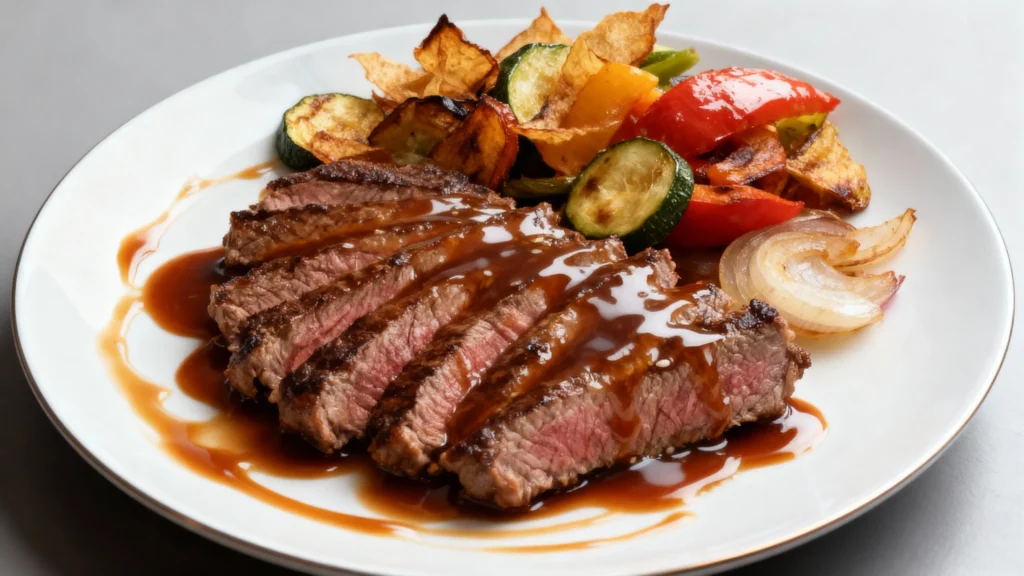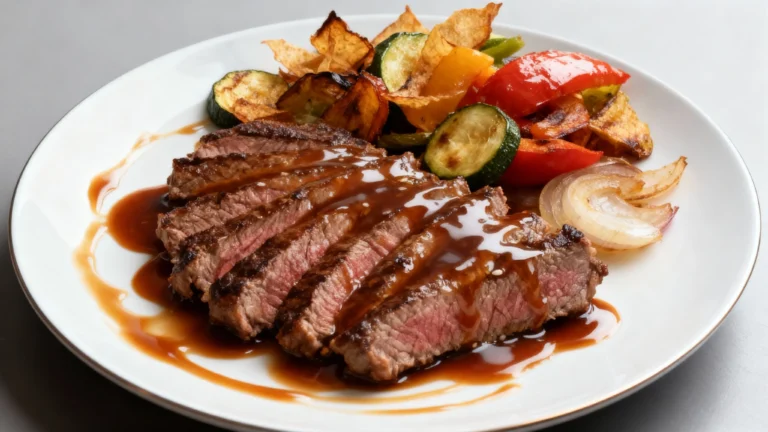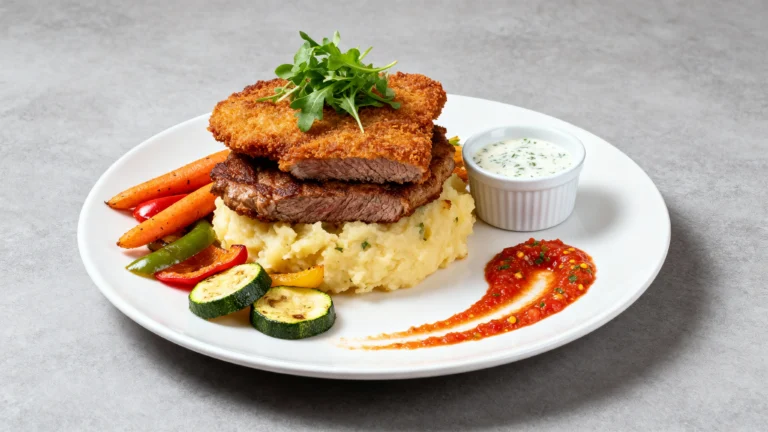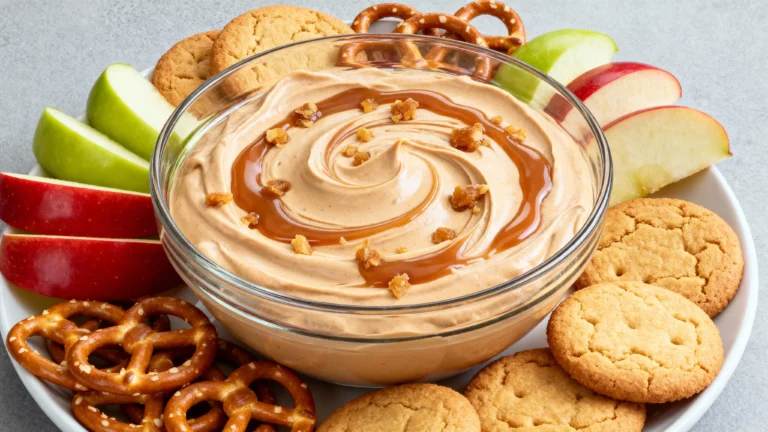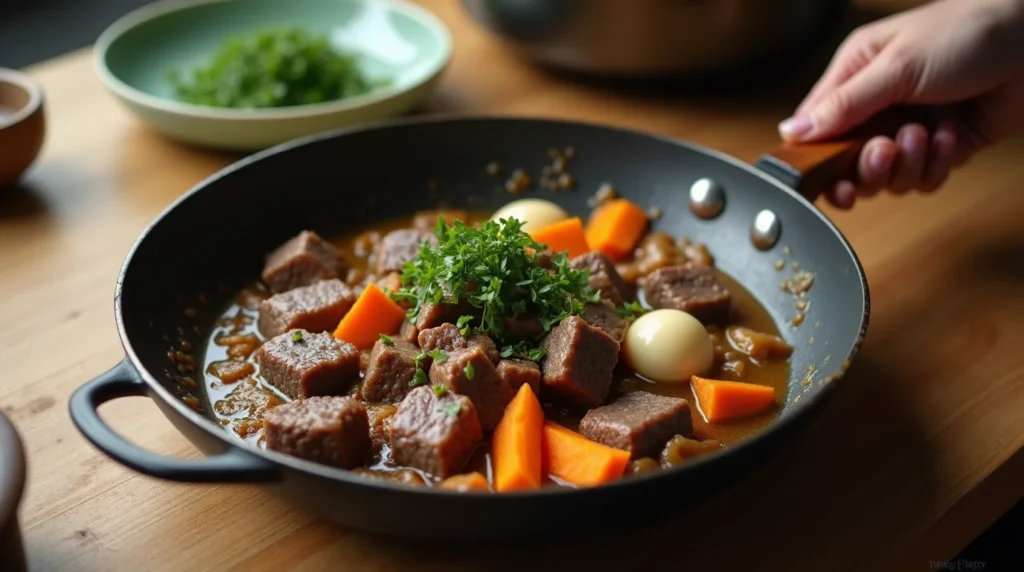
How to Make Perfectly Savory Beef Stew Roux Japanese Style
Share this recipe
Winter’s chill always brings me back to my grandmother’s kitchen. The rich aroma of beef stew roux japanese filled every corner. Her Japanese beef stew still warms my heart, turning simple ingredients into a culinary masterpiece.
Cooking is more than following recipes—it’s about connecting with generations of culinary wisdom. Japanese beef stew is more than a meal; it’s a journey through flavors, techniques, and cultural heritage. It invites you to explore a truly remarkable cooking experience.
Whether you’re a home cook or a food enthusiast, this guide will unlock the secrets of creating an extraordinary Japanese-style beef stew. It will transport your taste buds to the heart of Japan.
Key Takeaways
- Master the art of authentic Japanese beef stew roux techniques
- Understand the fundamental differences between Western and Japanese cooking styles
- Learn professional meat selection and preparation methods
- Discover traditional seasonings that elevate your stew
- Create restaurant-quality dishes in your home kitchen
Understanding Beef Stew Roux Japanese style Fundamentals
Exploring Japanese cuisine opens up a world where dashi roux is key to rich flavors. Japanese beef stew is a special take on comfort food, unlike Western cooking.
The Role of Roux in Japanese Cuisine
Roux is essential in Japanese dishes, especially in beef stew recipes. It turns simple ingredients into satisfying meals. It makes a smooth base that holds deep flavors.
- Provides rich texture to dishes
- Enhances overall flavor profile
- Creates smooth consistency in stews
Difference Between Western and Japanese Roux
Western roux uses butter and flour, but Japanese roux is different. The Japanese version often includes miso, soy sauce, and special spice blends. These ingredients give a unique taste.
“Japanese roux is an art form that transforms simple ingredients into culinary masterpieces.” – Traditional Japanese Chef
Key Components of Japanese Stew Base
To make authentic beef stew roux, you need to know its basics. The base includes:
- High-quality dashi stock
- Carefully selected spices
- Precise cooking techniques
- Balanced flavor profiles
Learning these elements will help you make a true Japanese beef stew. It will capture the heart of traditional Japanese cooking.
Essential Ingredients for Authentic Beef Stew Roux Japanese Style
To make a real wagyu stew, you need the right ingredients. These ingredients bring out the true taste of Japanese cooking. Your beef stew roux japanese-style starts with knowing the key parts that make it special.
The heart of a sukiyaki stew is in its ingredients:
- High-quality beef – like wagyu or a tender cut with lots of marbling
- Dashi stock – a traditional Japanese flavor base
- Soy sauce – for depth and umami
- Mirin – a sweet rice wine
- Sake – for more complexity
When picking ingredients for your beef stew roux japanese-style, quality is key. Fresh, real parts make the dish go from good to great.
“In Japanese cooking, ingredients tell a story of tradition and respect for each element.” – Traditional Japanese Chef
Your veggie choices are also important for a balanced wagyu stew. Think about adding:
- Onions
- Carrots
- Shiitake mushrooms
- Green onions
By choosing these ingredients carefully, you’ll make a sukiyaki stew that respects Japanese cooking traditions. It will also make your taste buds happy.
Selecting the Perfect Cut of Beef for Your Stew
Choosing the right beef is key for a great Japanese beef stew. The meat you pick can change the flavor, tenderness, and quality of your wagyu stew.
Premium Cuts vs Budget-Friendly Options
When making a Japanese beef stew, you have many meat choices:
- Premium cuts: Chuck roast, short ribs, and brisket offer rich flavor
- Budget-friendly alternatives: Shoulder cuts and bottom round provide good results
- Lean cuts require careful cooking to maintain tenderness
Wagyu Beef Considerations
“Not all wagyu is created equal – quality matters most in stew preparation.”
Wagyu beef adds amazing marbling and flavor to your stew. It’s pricey, but a little goes a long way. For the best taste, choose A5 grade wagyu.
Proper Meat Preparation Techniques
To get the best results for your beef stew roux japanese style, follow these tips:
- Trim excess fat, leaving some for flavor
- Cut meat into uniform 1-inch cubes
- Pat meat dry before browning
- Season generously with salt and pepper
The secret to a perfect wagyu stew is using high-quality meat and preparing it with care.
Kitchen Tools and Equipment You'll Need
Making an authentic Japanese beef stew is more than just using great ingredients. The right kitchen tools are key to a delicious beef stew roux Japanese style. Whether you’re cooking at home or love to cook, the right equipment makes a big difference.
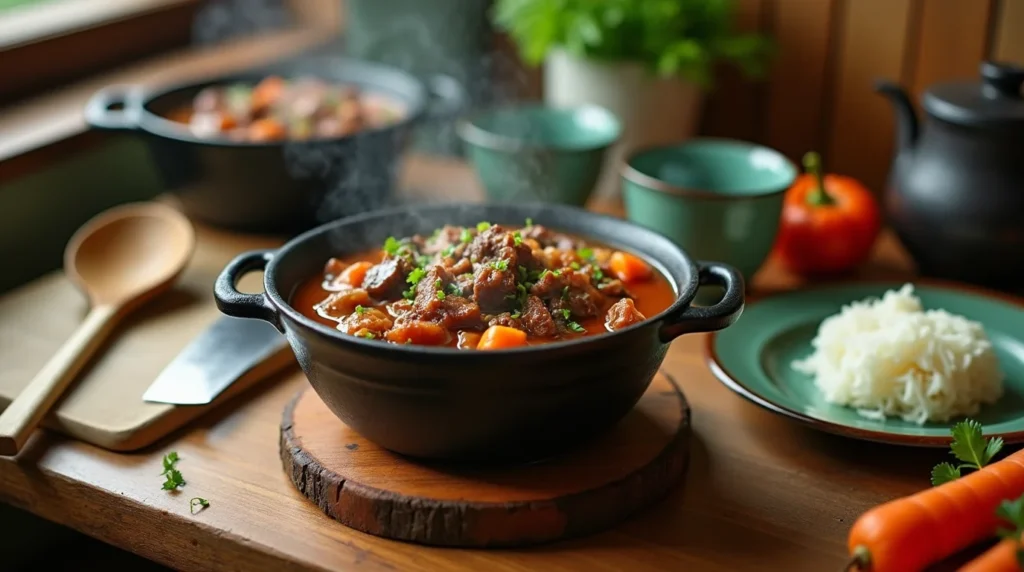
- Heavy-bottomed cast iron Dutch oven or enameled pot
- Sharp chef’s knife for precise meat cutting
- Wooden spoon or silicone spatula for stirring roux
- Measuring cups and spoons
- Donburi or deep ceramic cooking bowl
“The right tools transform cooking from a task to an art form.” – Traditional Japanese Cooking Wisdom
Professional chefs say quality Japanese cooking tools are worth the investment. A traditional nabe pot is perfect for beef stew roux Japanese recipes. If you’re on a tight budget, a heavy-bottomed pot works great too.
Here are some more tools you might want:
- Meat thermometer
- Kitchen scale for precise ingredient measurements
- Fine-mesh strainer for creating smooth roux
While special equipment helps, passion and technique are what make a great Japanese beef stew.
Step-by-Step Beef Stew Roux Japanese Preparation Guide
Making an authentic nikujaga needs care and love. This guide will help you make a delicious beef stew roux in the Japanese style. It will transport your taste buds on a flavorful journey to Japan.
First, get all your ingredients ready and set up your kitchen. The secret to a great Japanese beef stew is in the prep and technique.
Creating the Perfect Roux Base
Your beef stew roux is the flavor foundation. Start by:
- Melting butter in a heavy-bottomed pan
- Gradually whisking in flour until smooth
- Cooking the mixture until it turns a rich golden brown
“A flawless roux is the key to crafting an authentic Japanese stew.” – Traditional Japanese Chef
Meat Browning Techniques
Properly browning meat is key for deep flavors in your nikujaga. Follow these steps:
- Pat beef dry with paper towels
- Season generously with salt and pepper
- Sear in a hot pan until a golden-brown crust forms
Vegetable Integration Process
The final step is adding vegetables. Timing and technique are everything. Cut vegetables into uniform pieces for even cooking and flavor.
- Add root vegetables first
- Layer softer vegetables later
- Stir gently to maintain vegetable integrity
With these steps, you’ll make a nikujaga that’s as good as traditional Japanese cooking. Remember, practice makes perfect. Don’t worry if your first try isn’t perfect.
Traditional Japanese Seasonings and Spices
Creating an authentic beef stew roux japanese style requires understanding traditional seasonings. The right mix of flavors can take your dish to the next level.
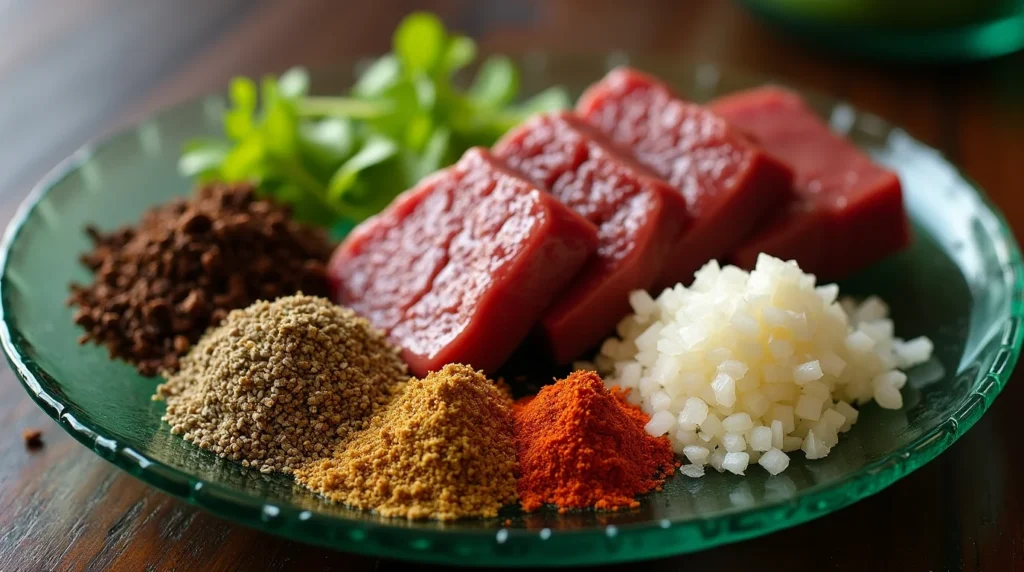
Japanese flavors are rooted in several key seasonings that make ponzu roux stand out:
- Shoyu (Soy Sauce): Adds a rich umami flavor
- Mirin: Sweet rice wine that adds a hint of sweetness
- Sake: Brings a complex, alcoholic taste
- Kombu: Dried kelp that enhances savory flavors
“Mastering Japanese seasonings is like conducting a culinary orchestra – each ingredient plays a critical role.”
When making your beef stew roux japanese style, balance these ingredients carefully. Adjusting the amounts lets you tailor the flavor to your liking.
Spices like shichimi togarashi and wasabi can add a surprising kick. They turn a simple stew into a memorable meal.
Mastering the Art of Roux Consistency
Making the perfect beef stew roux in a Japanese style needs precision and skill. The roux’s consistency is key. It can turn a simple meal into a work of art.
To get the right thickness, you must know a few important steps. The roux should be smooth, rich, and coat everything evenly.
Temperature Control Methods
Keeping the temperature right is vital when making dashi roux. Here are some must-do techniques:
- Start with medium-low heat to prevent burning
- Stir continuously to maintain even consistency
- Watch for subtle color changes indicating proper development
- Use a heavy-bottomed pan for consistent heat distribution
Achieving Ideal Thickness
The perfect beef stew roux needs careful attention to its thickness. You want a velvety sauce that sticks to meat and veggies but isn’t too thick or thin.
“Patience is the key to mastering the perfect roux.” – Japanese Culinary Master
To adjust the thickness, you can:
- Add liquid gradually while stirring
- Simmer to reduce and concentrate flavors
- Use cornstarch or flour as a thickening agent
- Let the stew rest to allow natural thickening
Pro tip: The ideal roux should coat the back of a spoon smoothly, creating a silky texture that defines authentic Japanese beef stew.
Common Mistakes to Avoid When Making Japanese Stew
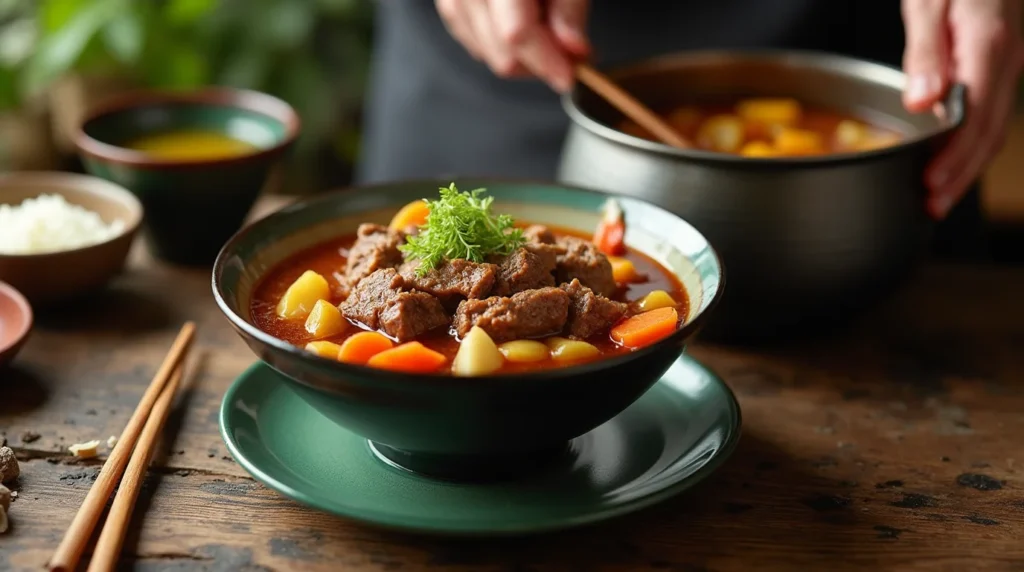
Making a tasty beef stew roux japanese style needs care and focus. Many home cooks make big mistakes that hurt the stew’s quality.
Here are the most common pitfalls to watch out for:
- Rushing the Roux: Making a perfect beef stew roux japanese-style takes time. Burning or undercooking the roux can ruin the dish’s flavor.
- Incorrect Meat Selection: Picking the wrong beef can make it tough and chewy instead of tender.
- Overlooking Seasoning Balance: Japanese beef stew needs a fine balance of flavors, which many beginners find hard to get right.
“Mastering a japanese beef stew is an art that requires practice and understanding of traditional techniques.”
When making your beef stew roux japanese style, controlling the temperature is key. Many cooks use too high heat, leading to uneven cooking. Keep the heat steady and low to get rich flavors and the right consistency.
Another big mistake is not preparing the meat right. Always dry your beef before browning and don’t overcrowd the pan. This helps get a nice golden crust that keeps the meat tender and flavorful.
- Make sure your ingredients are at room temperature
- Use fresh, high-quality ingredients
- Take your time with each cooking step
Knowing these common mistakes can make your japanese beef stew go from good to great. Remember, practice makes perfect. So, don’t worry if your first try isn’t perfect.
Serving Suggestions and Accompaniments
Your Japanese beef stew roux needs the right side dishes to shine. The right choices can turn a simple meal into a feast.
When making tonkatsu stew or shogayaki stew, think about these pairing ideas. They’ll make your meal complete and balanced.
Traditional Japanese Side Dishes
- Steamed white rice: The classic base for any Japanese stew
- Pickled vegetables (tsukemono): Adds crunch and tangy contrast
- Miso soup: Enhances the flavor of your beef stew
- Shredded cabbage: A light and refreshing side
Modern Pairing Options
Want to try something new with your tonkatsu stew? Here are some modern options:
- Quinoa instead of traditional rice
- Roasted sweet potato wedges
- Asian slaw with sesame dressing
- Cauliflower rice for a low-carb choice
“The right side dish can transform a good meal into an unforgettable culinary experience.” – Japanese Culinary Tradition
Your shogayaki stew is versatile, fitting both traditional and modern dining. Try different pairings to find your favorite.
Storage Tips and Reheating Methods
Keeping your beef stew roux japanese dish fresh is important. You need to store and reheat it right. This way, your stew will taste as good as when you first made it.
Storing your stew in the fridge is crucial. Here are some tips to keep it fresh:
- Cool the stew completely before storing
- Use airtight containers to prevent flavor loss
- Refrigerate within two hours of cooking
- Store for up to 3-4 days in the refrigerator
When you reheat your stew, use gentle methods. Avoid rapid high-heat cooking that can dry out the meat.
“The secret to maintaining the perfect beef stew roux japanese style is slow, careful reheating.” – Professional Chef
Here are some good ways to reheat your stew:
- Stovetop method: Low heat in a covered pot
- Oven warming: 325°F in a covered dish
- Microwave: Use medium power and stir occasionally
Pro tip: Add a bit of broth or water when reheating. This keeps the stew moist and flavorful.
Health Benefits and Nutritional Information
Learning about the nutritional value of beef stew roux Japanese style is key. It helps you choose better food options. Teriyaki beef stew is a healthy mix of proteins, nutrients, and flavors.
Preparing a beef stew roux Japanese recipe brings many health benefits:
- High-quality protein from beef cuts
- Essential vitamins and minerals
- Moderate caloric content
- Nutrient-dense vegetable components
Caloric Content and Macronutrients
A typical serving of teriyaki beef stew has about 350-450 calories. The breakdown is:
- Protein: 25-30 grams
- Carbohydrates: 15-20 grams
- Fat: 20-25 grams
Dietary Considerations and Modifications
You can adjust the beef stew roux Japanese recipe for different diets. Gluten-free individuals can use arrowroot or cornstarch instead of flour.
Nutrition isn’t about perfection, but about making mindful choices that support your health goals.
For those watching their intake, choose lean beef. Also, reduce extra fat while keeping the dish’s rich flavors.
Conclusion
Making a real Japanese beef stew roux is more than cooking. It’s a journey into Japanese cuisine’s rich traditions. By mastering flavors and techniques, you turn a simple dish into a special experience. This experience celebrates Japanese cooking’s depth and complexity.
Exploring the beef stew roux method shows the detailed skills needed for an exceptional meal. You’ve learned to choose the best beef and make a perfect roux. This shows that Japanese cooking is not just a recipe, but a sign of precision and care.
Keep practicing and improving your technique. Japanese cuisine values continuous learning and respect for ingredients. Your journey into Japanese beef stew cooking is just starting, filled with tasty adventures and a deeper love for this tradition.
Enjoy the process and the flavors of your homemade Japanese beef stew. Your kitchen is now a place where cultures meet and create unforgettable meals.
If you enjoyed this Japanese recipe, why not explore more World Flavors? Try dishes like Authentic Filipino Sinigang for a unique and flavorful culinary experience!
Beef Stew Roux Japanese style recipe
Description:
Experience the deep, umami-rich flavors of Beef Stew Roux Japanese style—a comforting dish made with tender braised beef, silky roux-based sauce, and aromatic Japanese seasonings. This dish blends traditional techniques with rich flavors, making it a must-try for home cooks and food lovers alike. Perfect for a cozy meal, served with rice or crusty bread!
Recipe Details:
- Serving Size: 4
- Prep Time: 20 minutes
- Cook Time: 2 hours
- Total Time: 2 hours 20 minutes
Ingredients (Per Serving)
Main Ingredients:
- ½ lb (250g) beef chuck or short ribs, cut into 1-inch cubes
- 1 small onion, thinly sliced
- 1 medium carrot, sliced into rounds
- 1 small potato, diced
- 2 shiitake mushrooms, sliced
- 2 tbsp vegetable oil
Japanese Stew Roux Base:
- 2 tbsp butter
- 2 tbsp flour
- 2 cups dashi stock (or beef broth)
- 2 tbsp soy sauce
- 1 tbsp mirin (sweet rice wine)
- 1 tbsp sake
- 1 tsp sugar
- ½ tsp salt
Garnish:
- Chopped parsley or green onions
- Steamed white rice (for serving)
Nutritional Facts (Per Serving)
- Calories: 480
- Protein: 32g
- Carbs: 28g
- Fats: 26g
- Fiber: 4g
- Sodium: 950mg
- Sugar: 7g
Step-by-Step Instructions
1. Prepare the Ingredients
1️⃣ Cut the beef into 1-inch cubes and pat dry with paper towels.
2️⃣ Slice the onion, carrot, potato, and mushrooms for even cooking.
2. Sear the Beef
1️⃣ Heat vegetable oil in a pot over medium heat.
2️⃣ Add the beef cubes and sear on all sides until golden brown.
3️⃣ Remove the beef and set aside.
3. Sauté the Vegetables
1️⃣ In the same pot, sauté onions until caramelized.
2️⃣ Add carrots, potatoes, and mushrooms. Stir for 2 minutes.
4. Make the Roux
1️⃣ In a small pan, melt butter over low heat.
2️⃣ Stir in flour and cook until light brown.
3️⃣ Slowly add dashi stock, whisking until smooth.
5. Simmer the Stew
1️⃣ Pour the roux mixture into the pot with the vegetables.
2️⃣ Add the seared beef, soy sauce, mirin, sake, sugar, and salt.
3️⃣ Cover and simmer on low heat for 1.5 to 2 hours, until the beef is tender.
6. Serve and Garnish
1️⃣ Ladle the thickened, rich stew onto a plate or bowl.
2️⃣ Garnish with chopped parsley and serve with steamed rice.

